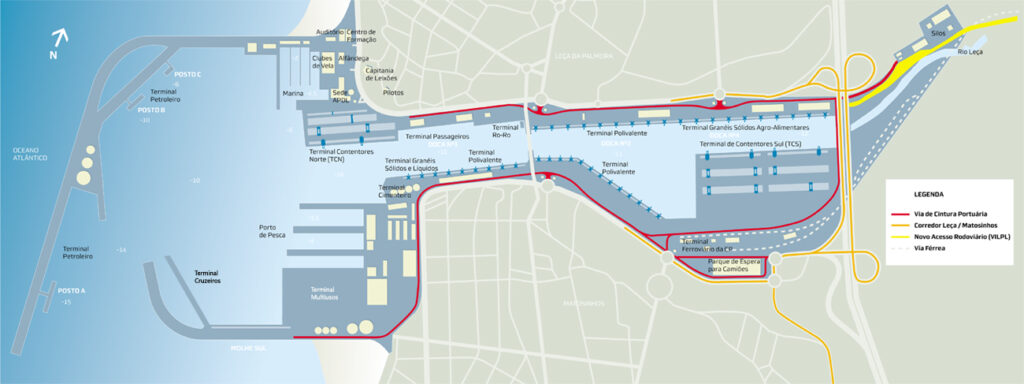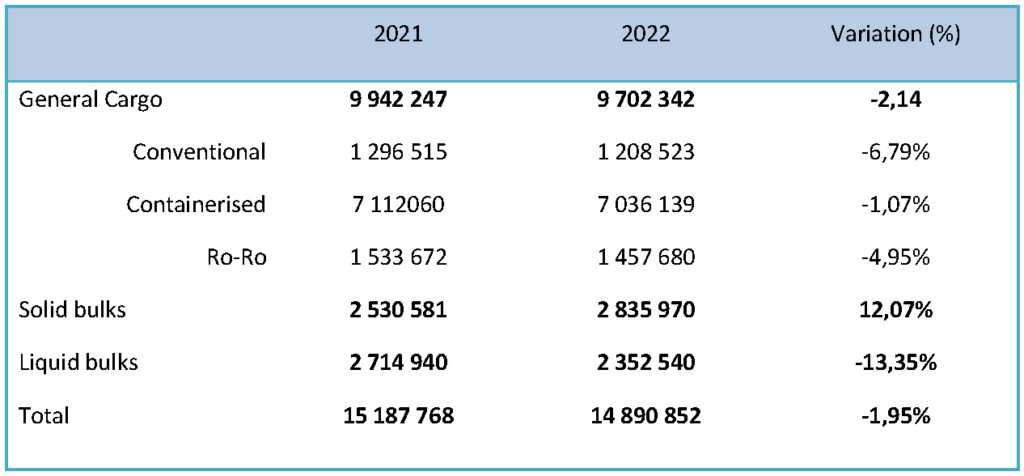╔
O Porto de Leixões
Folha de Informação
A criação do Porto de Leixões surge como alternativa aos problemas surgidos no antigo porto da foz do rio Douro, nomeadamente os naufrágios na barra, devido ao aumento da profundidade da embarcação.
A 3 de abril de 1852 foi emitido um decreto que nomeava uma Comissão de Engenheiros para fazer o estudo de um porto artificial em Leixões. Esta situar-se-ia na costa atlântica, 5 kms a norte da foz do rio Douro.
No entanto, datam do século XVIII os primeiros estudos a favor da construção de um porto na foz do rio Leça, aproveitando as rochas conhecidas por “Leixões” para a construção dos molhes.
Apresentados os inúmeros estudos realizados pelos mais conceituados engenheiros portugueses e estrangeiros, o projeto de Afonso Joaquim Nogueira Soares foi aprovado em 1883. A construção do porto de Leixões iniciou-se em 1884 e terminou em 1892.
A primeira tentativa de transformá-lo em porto comercial foi feita logo em 1893 pois ainda em curso a construção dos molhes as embarcações aqui vinham à procura de abrigo e começavam a fazer escala no porto para embarque e desembarque de passageiros e carga e descarga por meio de isqueiros.
No entanto, o primeiro passo para esta transformação só foi dado em 1914 com a construção de um troço de cais aproveitável no Molhe Sul.
A partir daí, o Porto de Leixões não parou mais de aumentar e melhorar as condições de abrigo e entrada dos navios que ali fazem escala.
The creation of the Port of Leixoes comes up with as an alternative to the problems arising in the old port at the entrance of the Douro river, more particularly the shipwrecks at the barre, because of growing of the vessel’s depth.
On the 3rd of April, 1852, a decree was issued naming a Commission of engineers to carry out the study of an artificial port in Leixões. This was to be located on the Atlantic coast, 5 kms north of the mouth of the Douro river.
Nevertheless, the first studies made in favour of the construction of a port in the mouth of the river Leça, taking advantage of the rocks known by “Leixões” for the construction of the moles, date back to the 18th century.
Once presented the countless studies made by the most famous Portuguese and foreign engineers, the project of Alfonso Joaquim Nogueira Soares was approved in 1883. The construction of Leixões harbour started in 1884 and ended in 1892.
The first attempt to turn it into a commercial port was made right in 1893 as while the construction of the moles was still in progress the vessels came here looking for shelter and started to call at the port for embarking and disembarking passengers and loading and unloading cargo by means of lighters.
However, the first step towards this transformation was only taken in 1914 with the construction of a section of usable quay on the South Mole.
From then on, the Port of Leixões never stopped in increasing and improving the shelter and entrance conditions for the ships calling at the port.

Mapa funcional do Porto de Leixões. (Fonte: APDL).
Functional map of the Port of Leixoes. (Source: APDL).
Conforme se fez necessário, foram feitos investimentos em obras de ampliação e aquisição de equipamentos para o porto comercial.
Um porto de pesca e uma marina de iates foram construídos para atender ao aumento de tráfego e diversidade.
Atualmente, o hinterland do Porto de Leixões, com uma área de cerca de 60 kms, tem uma população de 4 milhões de habitantes.
No entanto, este porto serve não só toda esta zona como também:
- Centro/Norte de Portugal, uma região altamente industrializada onde se situam cerca de 70% das pequenas e médias empresas portuguesas;
- Norte/Oeste de Espanha, agora ligado ao Porto de Leixões através de uma moderna rede viária que facilita o acesso ao porto, às fronteiras Norte e Centro e à rede rodoviária espanhola.
Hoje os 15 milhões de toneladas de cargas diversas que passam pelo Porto de Leixões e movimentadas em cais especializados em carga geral, granéis sólidos, granéis líquidos, tráfego Ro-Ro e carga contentorizada (2 terminais de contentores), representam 25% do comércio exterior português.
Além do porto comercial, a infra-estrutura portuária de Leixões compreende o maior porto de pesca de Portugal e uma marina de iates dotada de condições para servir os iates e outras embarcações de recreio de forma eficiente e adequada.
Sendo uma porta de entrada não só para a Europa mas para todo o mundo, o Porto de Leixões estabelece relações comerciais com vários portos, de Luanda ou Maputo a Hamburgo ou Roterdão, de Hong Kong ou Nakanoseki a Nova Orleães ou Baltimore.
O Porto de Leixões ocupa um lugar de destaque no quadro das infra-estruturas portuárias da Comunidade Europeia.
As it became necessary investments were made in works of enlargement and purchase of equipment for the commercial port.
A fishing harbour and a yacht marina were built to meet the traffic increase and diversity.
At present, the Port of Leixões hinterland, covering an area of some 60 kms, has a population of 4 million.
However, this port serves not only this whole area but also:
- The Centre/North of Portugal, a highly industrialised region where nearly 70% of the Portuguese small and medium-size enterprises are located in;
- The North/West of Spain, now connected with the Port of Leixões through a modern road network facilitating access to the port, the North and Centre borders and the Spanish road network.
Today the 15 million tons of various cargo coming through the Port of Leixões and handled in quays specialized in general cargo, solid bulk, liquid bulk, Ro-Ro traffic and containerised cargo (2 container terminals), represents 25% of the Portuguese foreign trade.
Besides the commercial port, Leixões port infrastructure comprises the biggest fishing harbour of Portugal and a yacht marina provided with conditions to serve the yachts and other pleasure boats in an efficient and adequate way.
Being a gateway not only to Europe but to the whole world, the Port of Leixões establishes commercial relations with various ports, from Luanda or Maputo to Hamburg or Rotterdam, from Hong Kong or Nakanoseki to New Orleans or Baltimore.
The Port of Leixões occupies an outstanding place in the framework of the European Community Port infra-structures.
Tráfego do Porto de Leixões (toneladas). (Fonte: APDL).
Port of Leixões traffic (tons). (Source: APDL).

IMAGEM INICIAL | Terminal Ferroviário de Mercadorias no Porto de Leixões. (Fonte: APDL).
HEAD IMAGE | “Terminal Ferroviário de Mercadorias” in the Port of Leixões. (Source: APDL).